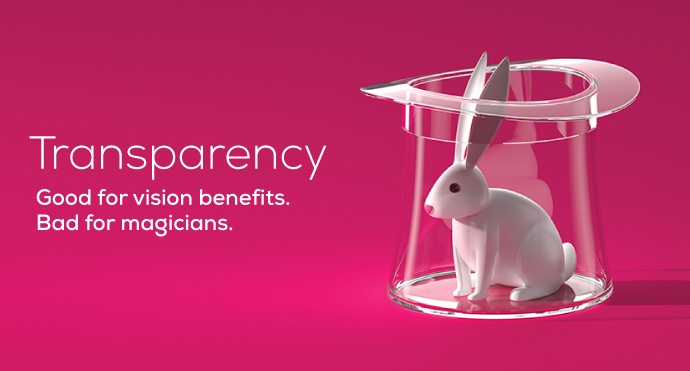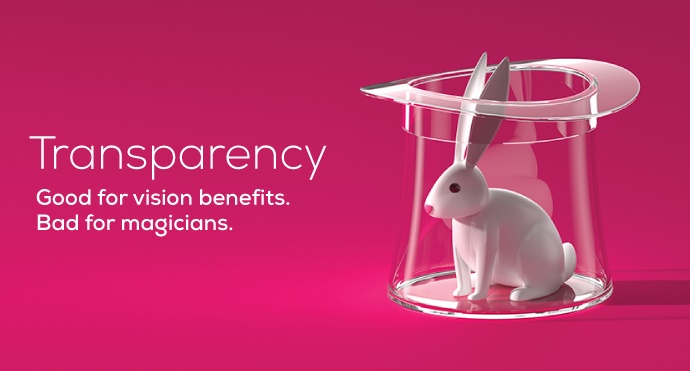Vision, dental and other “voluntary” employee benefits may not be required, but discerning employees are increasingly demanding them, making vision and other supplemental health options a deciding factor in job searches.1 Here’s why, and how your organization can benefit.
Hindsight may be 20-20, but that doesn’t make the future of employee benefits unclear. And based on trends of the past few years, many employees have their sights set on comprehensive vision benefits.
Companies that don’t offer them are learning to decipher the differences between these “voluntary” benefits and what employees consider essential. More than half of HR professionals agree that the availability of voluntary benefits, including vision, help attract and retain talent.2 And workers choose these companies for good reason: even a small business can get less-expensive rates for these benefits than an individual employee could.3
Coverage for eye exams, prescription lenses and frames could in fact be more enticing than free snacks and wellness programs when it comes to recruiting and retaining talent. Vision benefits rank 5th in overall importance among benefit options, closely after dental insurance, with 67% of workers considering it a “must-have.” Yet just 62% of companies offer a vision benefit.4
Employees have become discriminating benefit customers
The sale of voluntary benefits has grown at a compounded annual rate of 5% a year over the past decade5 as employees, particularly younger workers, seek more benefit choices and customization in their quest for overall wellness.
The 2020 pandemic has sharpened their focus on well-being and the voluntary benefits that support it. Workers are placing “renewed value on feeling safe, protected and prepared across all areas of well-being,” according to a 2021 report by MetLife.6
They expect their employers to support this renewed focus on feeling safe, and many are: At least 2/3 of companies that provide voluntary benefits offer at least 3, while 30% offers 6 or more .7
Look at the average workplace and you can see why. One workforce can comprise up to 5 generations, several ethnicities and a spectrum of family situations. These employees need more flexibility and choices, and voluntary benefits provide that.8
And just as vision and other supplemental benefits are climbing to “must-have” status, organizations that offer them can become “must-have” employers.

61 million members choose EyeMed for a reason
With 2/3 of workers deeming vision care a must-have benefit,3 there is little question of its value as an employee recruitment and retention tool. To some, that writing on the wall may be an eye chart, but it also is the portal to overall better health, wellness and productivity.
Speak with an EyeMed representative to learn more about benefit packages, and what options may best suit your organization, here.
••••
1 - Managed Healthcare Executive, "Top Productivity Boost at Work is Resting Eyes," Transitions Optical Workplace Wellness Survey, 2020.
2 - “Vision plan coverage: Impacting employee retention, productivity and well-being,” by Versant Health, BenefitsPro, April 27, 2021.
3 - “Voluntary Benefits for Small Business” By Louise Norris, eHealth, Jan. 29, 2020.
4 - “Redesigning the Employee Experience: Preparing the Workforce for a Transformed World,” MetLife’s 19th Annual U.S. Employee Benefit Trends Study, 2021, page 33.
5 - “4 voluntary benefit trends to expect in 2021 as a pandemic-weary workforce faces new realities,” By Mike Wilbert, BenefitsPro, Dec. 4, 2020.
6 - “Redesigning the Employee Experience: Preparing the Workforce for a Transformed World,” MetLife’s 19th Annual U.S. Employee Benefit Trends Study, 2021, page 33.
7 - “Voluntary Benefits 2020 and Beyond,” by Trey Loughran, BenefitsPro, Jan. 24, 2020.
8 - “What Are Voluntary Benefits and Why Should I Consider Them?” By Michele Moffitt, Nov. 8, 2018.


